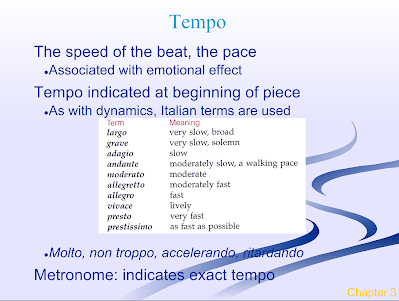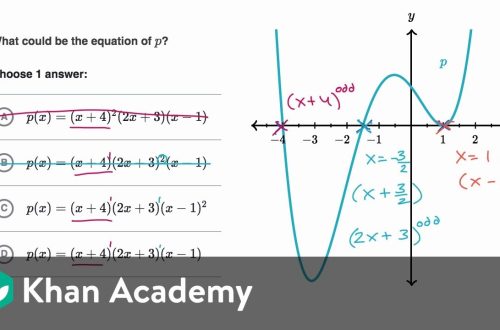
Three types of minor in music
Contents
The minor scale has three main varieties: natural minor, harmonic minor, and melodic minor.
About the features of each of these modes and how to get them, we will talk today.
Natural minor – simple and strict
Natural minor is a scale built according to the formula “tone – semitone – 2 tones – semitone – 2 tones”. This is a common scheme for the structure of a minor scale, and in order to quickly get it, it is enough just to know the key signs in the desired key. There are no altered degrees in this type of minor, so there can be no accidental signs of alteration in it.

For example, A minor is a scale without signs. Accordingly, natural A minor is a scale of notes la, si, do, re, mi, fa, sol, la. Or another example, the D minor scale contains one sign – B flat, which means that the natural D minor scale is the movement of steps in a row from D to D through B flat. If the signs in the desired keys are not immediately remembered, then you can recognize them using the circle of fifths, or focusing on the parallel major.

The natural minor scale sounds simple, sad and a bit strict. That is why natural minor is so common in folk and medieval church music.
An example of a melody in this mode: “I’m sitting on a stone” – a famous Russian folk song, in the recording below, its key is natural E minor.
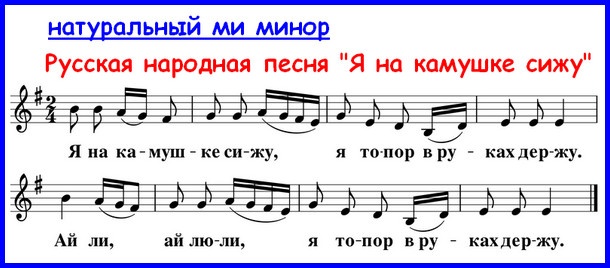
Harmonic minor – the heart of the East
In the harmonic minor, the seventh step is raised compared to the natural form of the mode. If in the natural minor the seventh step was a “pure”, “white” note, then it rises with the help of a sharp, if it was a flat, then with the help of a becar, but if it was a sharp, then a further increase in the step is possible with the help of a double -sharp. Thus, this type of mode can always be recognized by the appearance of one random accidental sign.
![]()
For example, in the same A minor, the seventh step is the sound of G, in the harmonic form it will be not just G, but G-sharp. Another example: C minor is a tonality with three flats at the key (si, mi and la flat), the note si-flat falls on the seventh step, we raise it with a becar (si-becar).
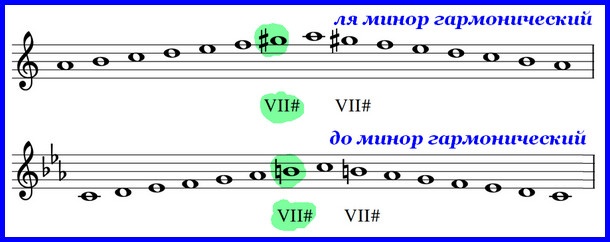
Due to the increase of the seventh step (VII #), the structure of the scale changes in the harmonic minor. The distance between the sixth and seventh steps becomes as much as one and a half tones. This ratio causes the appearance of new increased intervals, which were not there before. Such intervals include, for example, an augmented second (between VI and VII#) or an augmented fifth (between III and VII#).

The harmonic minor scale sounds tense, has a characteristic Arabic-oriental flavor. However, despite this, it is the harmonic minor that is the most common of the three types of minor in European music – classical, folk or pop-pop. It got its name “harmonic” because it shows itself very well in chords, that is, in harmony.
An example of a melody in this mode is a Russian folk “Song of the Bean” (the key is in A minor, the appearance is harmonic, as a random G-sharp tells us).
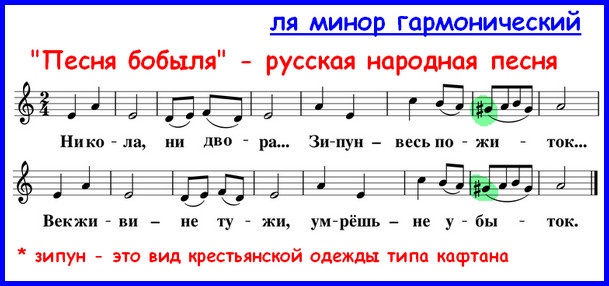
The composer can use different types of minor in the same work, for example, alternate natural minor with harmonic, as Mozart does in the main theme of his famous Symphonies No. 40:
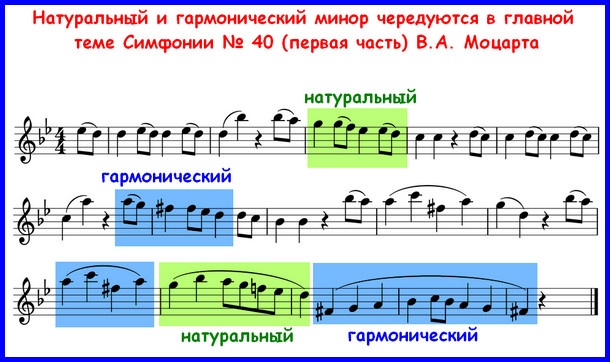
Melodic minor – emotional and sensual
The melodic minor scale is different when it is moved up or down. If they go up, then two steps are raised at once in it – the sixth (VI #) and the seventh (VII #). If they play or sing down, then these changes are canceled, and an ordinary natural minor sounds.

For example, the scale of A minor in a melodic ascending motion will be a scale of the following notes: la, si, do, re, mi, f-sharp (VI#), sol-sharp (VII#), la. When moving down, these sharps will disappear, turning into G-becar and F-becar.
Or the gamma in C minor in the melodic ascending movement is: C, D, E-flat (with key), F, G, A-becar (VI#), B-becar (VII#), C. Back-raised notes will turn back into B-flat and A-flat as you move down.

By the name of this type of minor, it is clear that it is intended to be used in beautiful melodies. Since the melodic minor sounds diverse (not equally up and down), it is able to reflect the most subtle moods and experiences when it appears.
When the scale ascends, its last four sounds (for example, in A minor – mi, F-sharp, G-sharp, la) coincide with the scale of the major of the same name (A major in our case). Therefore, they can convey light shades, motives of hope, warm feelings. Movement in the opposite direction along the sounds of the natural scale absorbs both the severity of the natural minor, and, perhaps, some kind of doom, or maybe the fortress, the confidence of the sound.
With its beauty and flexibility, with its wide possibilities in conveying feelings, the melodic minor was very fond of composers, which is probably why it can be found so often in famous romances and songs. Let’s take the song as an example “Moscow Nights” (music by V. Solovyov-Sedoy, lyrics by M. Matusovsky), where the melodic minor with raised steps sounds at the moment when the singer talks about his lyrical feelings (If you knew how dear to me …):
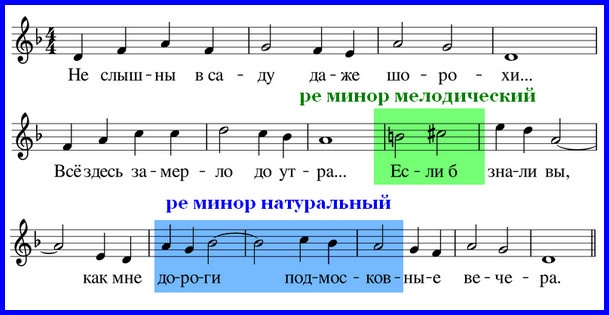
Let’s do it again
So, there are 3 types of minor: the first is natural, the second is harmonic and the third is melodic:
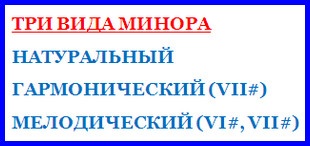
- Natural minor can be obtained by constructing a scale using the formula “tone-semitone-tone-tone-semitone-tone-tone”;
- In the harmonic minor, the seventh degree (VII#) is raised;
- In the melodic minor, when moving up, the sixth and seventh steps (VI# and VII#) are raised, and when moving back, the natural minor is played.
To work on this theme and remember how the minor scale sounds in different forms, we highly recommend watching this video by Anna Naumova (sing along with her):
Training exercises
To reinforce the topic, let’s do a couple of exercises. The task is this: write, speak or play on the piano the scales of 3 types of minor scales in E minor and G minor.
SHOW ANSWERS:
Gamma E minor is sharp, it has one F-sharp (parallel tonality of G major). There are no signs in the natural minor, except for the key ones. In the harmonic E minor, the seventh step rises – it will be a D-sharp sound. In the melodic E minor, the sixth and seventh steps rise in the ascending movement – the sounds of C-sharp and D-sharp, in the descending movement these rises are canceled.


The G minor gamma is flat, in its natural form there are only two key signs: B-flat and E-flat (parallel system – B-flat major). In the harmonic G minor, raising the seventh degree will lead to the appearance of a random sign – F sharp. In the melodic minor, when moving up, the elevated steps give the signs of E-becar and F-sharp, when moving down, everything is as in natural form.
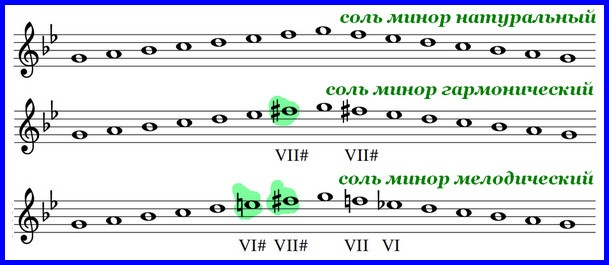

[collapse]
Minor scale table
For those who still find it difficult to immediately imagine minor scales in three varieties, we have prepared a hint table. It contains the name of the key and its letter designation, the image of key characters – sharps and flats in the right amount, and also names random characters that appear in the harmonic or melodic form of the scale. In total, fifteen minor keys are used in music:


How to use such a table? Consider the scales in B minor and F minor as an example. There are two key signs in B minor: F-sharp and C-sharp, which means that the natural scale of this key will look like this: B, C-sharp, D, E, F-sharp, G, A, Si. The harmonic B minor will include A-sharp. In the melodic B minor, two steps will already be changed – G-sharp and A-sharp.
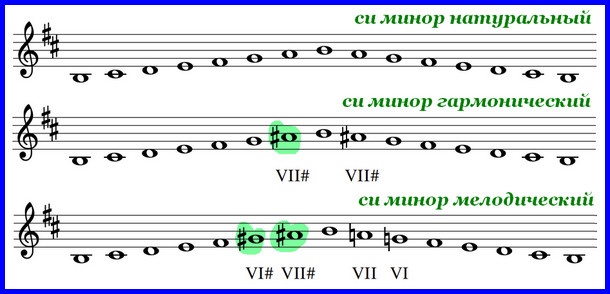

In the F minor scale, as is clear from the table, there are four key signs: si, mi, la and d-flat. So the natural F minor scale is: F, G, A-flat, B-flat, C, D-flat, E-flat, F. In the harmonic F minor – mi-bekar, as an increase in the seventh step. In melodic F minor – D-becar and E-becar.
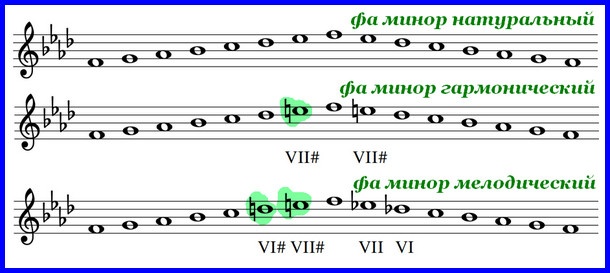

That’s all for now! In future issues, you will learn that there are other types of minor scales, as well as what are the three types of major. Stay tuned, join our Facebook group to keep up to date!



